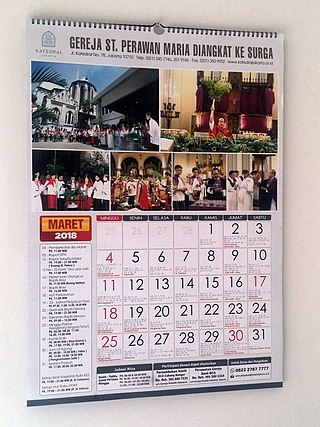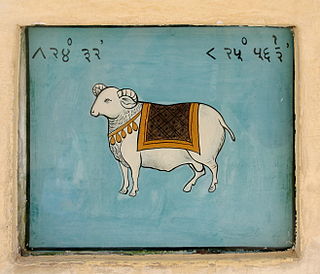
A calendar is a system of organizing days. This is done by giving names to periods of time, typically days, weeks, months and years. A date is the designation of a single and specific day within such a system. A calendar is also a physical record of such a system. A calendar can also mean a list of planned events, such as a court calendar, or a partly or fully chronological list of documents, such as a calendar of wills.

The traditional Chinese calendar is a lunisolar calendar, combining the solar, lunar, and other cycles for various social and agricultural purposes. More recently, in China and Chinese communities the Gregorian calendar has been adopted and adapted in various ways, and is generally the basis for standard civic purposes, though also incorporating traditional lunisolar holidays. Also, there are many types and subtypes of the Chinese calendar, partly reflecting developments in astronomical observation and horology, with over a millennium's worth of history. The major modern form is the Gregorian calendar-based official version of Mainland China, though diaspora versions are also notable in other regions of China and Chinese-influenced cultures; however, aspects of the traditional lunisolar calendar remain popular, including the association of the twelve animals of the Chinese Zodiac in relation to months and years.

Astronomy is the oldest of the natural sciences, dating back to antiquity, with its origins in the religious, mythological, cosmological, calendrical, and astrological beliefs and practices of prehistory: vestiges of these are still found in astrology, a discipline long interwoven with public and governmental astronomy. It was not completely separated in Europe during the Copernican Revolution starting in 1543. In some cultures, astronomical data was used for astrological prognostication.
A lunar calendar is a calendar based on the monthly cycles of the Moon's phases, in contrast to solar calendars, whose annual cycles are based on the solar year. The most widely observed purely lunar calendar is the Islamic calendar. A purely lunar calendar is distinguished from a lunisolar calendar, whose lunar months are brought into alignment with the solar year through some process of intercalation – such as by insertion of a leap month. The details of when months begin vary from calendar to calendar, with some using new, full, or crescent moons and others employing detailed calculations.

A lunisolar calendar is a calendar in many cultures, incorporating lunar calendars and solar calendars. The date of lunisolar calendars therefore indicates both the Moon phase and the time of the solar year, that is the position of the Sun in the Earth's sky. If the sidereal year is used instead of the solar year, then the calendar will predict the constellation near which the full moon may occur. As with all calendars which divide the year into months there is an additional requirement that the year have a whole number of months. In some case ordinary years consist of twelve months but every second or third year is an embolismic year, which adds a thirteenth intercalary, embolismic, or leap month.
A month is a unit of time, used with calendars, that is approximately as long as a natural orbital period of the Moon; the words month and Moon are cognates. The traditional concept of months arose with the cycle of Moon phases; such lunar months ("lunations") are synodic months and last approximately 29.53 days, making for roughly 12.37 such months in one Earth year. From excavated tally sticks, researchers have deduced that people counted days in relation to the Moon's phases as early as the Paleolithic age. Synodic months, based on the Moon's orbital period with respect to the Earth–Sun line, are still the basis of many calendars today and are used to divide the year.

A lunar phase or Moon phase is the apparent shape of the Moon's directly sunlit portion as viewed from the Earth. In common usage, the four major phases are the new moon, the first quarter, the full moon and the last quarter; the four minor phases are waxing crescent, waxing gibbous, waning gibbous, and waning crescent. A lunar month is the time between successive recurrences of the same phase: due to the eccentricity of the Moon's orbit, this duration is not perfectly constant but averages about 29.5 days.

In astronomy, the new moon is the first lunar phase, when the Moon and Sun have the same ecliptic longitude. At this phase, the lunar disk is not visible to the naked eye, except when it is silhouetted against the Sun during a solar eclipse.
A solar calendar is a calendar whose dates indicate the season or almost equivalently the apparent position of the Sun relative to the stars. The Gregorian calendar, widely accepted as a standard in the world, is an example of a solar calendar. The main other types of calendar are lunar calendar and lunisolar calendar, whose months correspond to cycles of Moon phases. The months of the Gregorian calendar do not correspond to cycles of the Moon phase.
The Hindu calendar, also called Panchanga, is one of various lunisolar calendars that are traditionally used in the Indian subcontinent and Southeast Asia, with further regional variations for social and Hindu religious purposes. They adopt a similar underlying concept for timekeeping based on sidereal year for solar cycle and adjustment of lunar cycles in every three years, but differ in their relative emphasis to moon cycle or the sun cycle and the names of months and when they consider the New Year to start. Of the various regional calendars, the most studied and known Hindu calendars are the Shalivahana Shaka found in the Deccan region of Southern India and the Vikram Samvat (Bikrami) found in Nepal and the North and Central regions of India – both of which emphasize the lunar cycle. Their new year starts in spring. In regions such as Tamil Nadu and Kerala, the solar cycle is emphasized and this is called the Tamil calendar and Malayalam calendar and these have origins in the second half of the 1st millennium CE. A Hindu calendar is sometimes referred to as Panchangam (पञ्चाङ्गम्), which is also known as Panjika in Eastern India.
The epact used to be described by medieval computists as the age of a phase of the Moon in days on 22 March; in the newer Gregorian calendar, however, the epact is reckoned as the age of the ecclesiastical moon on 1 January. Its principal use is in determining the date of Easter by computistical methods. It varies from year to year, because of the difference between the solar year of 365–366 days and the lunar year of 354–355 days.
The history of calendars covers practices with ancient roots as people created and used various methods to keep track of days and larger divisions of time. Calendars commonly serve both cultural and practical purposes and are often connected to astronomy and agriculture.

Yajnavalkya or Yagyavalkya is a Hindu Vedic sage featuring in the Brihadaranyaka Upanishad. Yajnavalkya proposes and debates metaphysical questions about the nature of existence, consciousness and impermanence, and expounds the epistemic doctrine of neti neti to discover the universal Self and Ātman. Texts attributed to him include the Yajnavalkya Smriti, Yoga Yajnavalkya and some texts of the Vedanta school. He is also mentioned in various Brahmanas and Aranyakas.
The Shatapatha Brahmana is a commentary on the Śukla Yajurveda. It is attributed to the Vedic sage Yajnavalkya. Described as the most complete, systematic, and important of the Brahmanas, it contains detailed explanations of Vedic sacrificial rituals, symbolism, and mythology.

A panchāngam is a Hindu calendar and almanac, which follows traditional units of Hindu timekeeping, and presents important dates and their calculations in a tabulated form. It is sometimes spelled Panchāngamu, Pancanga, Panchanga, Panchaanga, or Panchānga, and is often pronounced Panchāng. Panchangas are used in Jyotisha.

Indian astronomy refers to astronomy practiced in the Indian subcontinent. It has a long history stretching from pre-historic to modern times. Some of the earliest roots of Indian astronomy can be dated to the period of Indus Valley civilisation or earlier. Astronomy later developed as a discipline of Vedanga, or one of the "auxiliary disciplines" associated with the study of the Vedas dating 1500 BCE or older. The oldest known text is the Vedanga Jyotisha, dated to 1400–1200 BCE.
Often called lunar mansion, a lunar station or lunar house is a segment of the ecliptic through which the Moon passes in its orbit around the Earth. The concept was used by several ancient cultures as part of their calendrical system.

The Epic-Puranic chronology is a timeline of Hindu mythology based on the Itihasa and the Puranas. These texts have an authoritaive status in Indian tradition, and narrate cosmogeny, royal chronologies, myths and legendary events. The central dates here are the Kurukshetra War and the start of the Kali Yuga. The Epic-Puranic chronology is referred to by proponents of Indigenous Aryans to propose an earlier dating of the Vedic period, and the spread of Indo-European languages out of India, arguing that "the Indian civilization must be viewed as an unbroken tradition that goes back to the earliest period of the Sindhu-Sarasvati Valley traditions ."

Mesha Sankranti refers to the first day of the solar cycle year, that is the solar New Year in the Hindu luni-solar calendar. The Hindu calendar also has a lunar new year, which is religiously more significant. The solar cycle year is significant in Assamese, Odia, Punjabi, Malayalam, Tamil, and Bengali calendars.
Yajnavalkya's theory of heliocentrism is the heliocentric model of the Solar System mentioned in the Vedic text Shatapatha Brahmana. It was proposed by the Indian philosopher Yajnavalkya.










